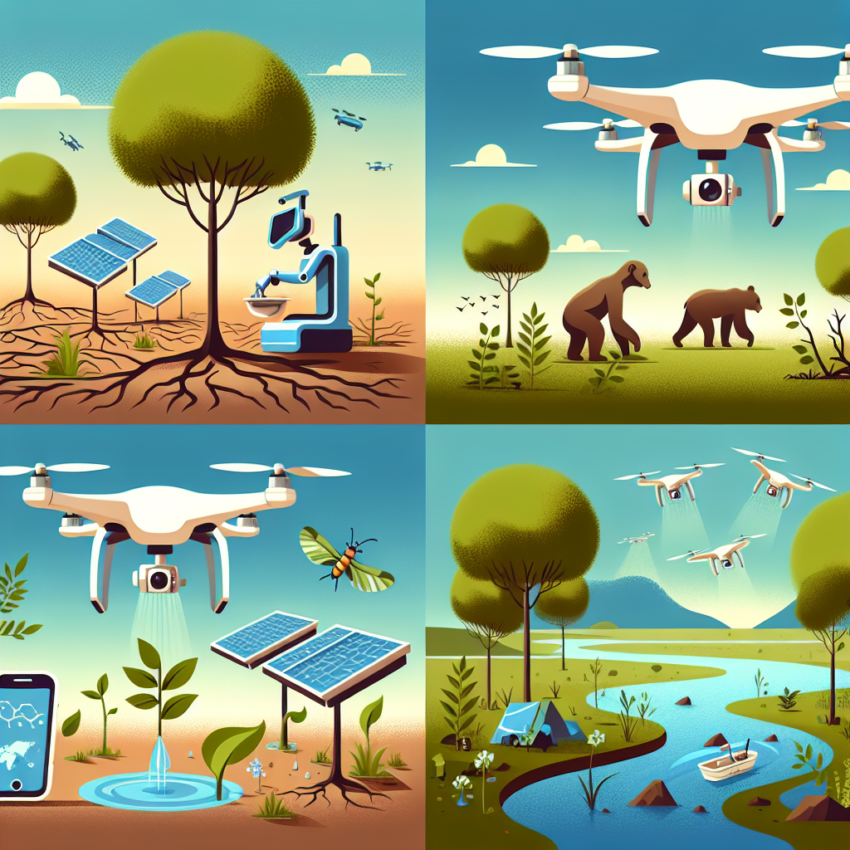Introduction
In recent years, the advent of drone technology has paved the way for revolutionary changes in various sectors, including environmental conservation. Drones, or Unmanned Aerial Vehicles (UAVs), are increasingly being employed to monitor ecosystems, conduct wildlife surveys, and support conservation efforts. They provide a cost-effective and efficient solution for gathering critical data, thus enhancing our understanding and preservation of the natural world. In this article, we will explore the numerous ways drones are advancing environmental conservation, the challenges they help overcome, and the future potential of this technology in safeguarding our planet.
The Role of Drones in Environmental Monitoring
1. Aerial Surveys and Data Collection
Drones play a pivotal role in collecting data over large areas that are often difficult or dangerous to access. Equipped with high-resolution cameras and sensors, they can capture detailed images and gather data in real-time. This capability is crucial for:
- Mapping Ecosystems: Drones can create precise maps of various ecosystems, which aids in understanding habitat changes and biodiversity.
- Monitoring Vegetation: By analyzing spectral images, drones can assess plant health, species distribution, and forest cover changes.
- Mapping Coasts: Coastal areas can be monitored for erosion, vegetation changes, and habitat degradation, aiding in restoration efforts.
2. Wildlife Tracking and Conservation
Monitoring wildlife is essential for conservationists to protect endangered species and maintain balanced ecosystems. Drones are used for:
- Tracking Animal Movements: With the help of GPS and thermal imaging, drones can track animals in their natural habitat without disturbing them.
- Protecting Endangered Species: Drones can help in monitoring poaching activities, allowing for timely intervention.
- Studying Behavior: Researchers can observe wildlife behavior from above, gaining insights without human interference.
Challenges Addressed by Drones
1. Accessibility to Remote Areas
Many regions, such as dense forests, deserts, and mountainous areas, are challenging to reach by traditional means. Drones can easily access these areas and deliver comprehensive data without putting human operators at risk.
2. Cost-Effectiveness
Traditional environmental surveys often require extensive manpower, transportation, and time, leading to high costs. Drones offer a more economical solution, allowing conservation organizations to allocate their resources more effectively.
3. Reduced Disturbance to Wildlife
Conventional wildlife monitoring techniques, such as human presence or traps, may disrupt the animals’ natural behavior. Drones provide a non-intrusive approach, minimizing stress on wildlife and ensuring more accurate data collection.
Case Studies: Drones in Action
1. The Great Green Wall Initiative
The Great Green Wall Initiative aims to combat desertification across Africa. Drones are utilized to monitor the progress of tree planting and assess the health of newly established ecosystems. By analyzing vegetation indices, conservationists can determine areas that require additional attention and resources.
2. Rhino Conservation in South Africa
In South Africa, drones are being deployed to protect endangered rhinoceroses from poachers. Equipped with night vision and thermal imaging, drones can detect poacher movements and alert ground teams for rapid response. This innovative technology has significantly increased protection efficiency.
3. Monitoring Coral Reefs
Coral reefs are vital ecosystems that are unfortunately declining worldwide. Drones are used to monitor reef health by capturing images and assessing bleaching events. This information is crucial for conservationists to implement restoration activities effectively.
The Future of Drones in Environmental Conservation
1. Technological Advancements
As technology continues to evolve, we can expect more sophisticated drones with advanced sensors and AI capabilities. These advancements will enable even more effective data collection, analysis, and decision-making in conservation efforts.
2. Integration with Other Technologies
The integration of drones with satellite imagery and machine learning algorithms will enhance the accuracy of environmental monitoring. By combining these technologies, conservationists can create a more comprehensive understanding of environmental dynamics.
3. Broader Adoption
In the coming years, we anticipate a wider adoption of drones across various conservation projects worldwide. Increasing awareness of their benefits, combined with decreasing costs, will make drones a standard tool for environmental monitoring.
Conclusion
Drones are revolutionizing the field of environmental conservation by providing innovative solutions for monitoring, data collection, and wildlife protection. As we face increasing environmental challenges, such as climate change and habitat loss, the role of drones will only expand. By harnessing the power of this technology, we can significantly improve our conservation efforts and work towards a sustainable future for our planet.

